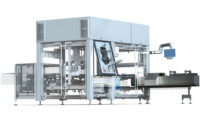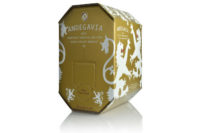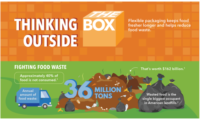Secondary Packaging Trends
Thinking outside the box
Talking trends in secondary packaging with Bernhard Vaihinger, Bosch Packaging Technology.

In the past, the main purpose of secondary packaging was to shield the products within from knocks and prevent wasteful loss during transit from the manufacturer to the retailer. However, in the last few years, secondary packaging has been increasingly used by both brands and retailers to attract consumers at the point of sale. Bernhard Vaihinger, head of product management, innovation and technology at Bosch Packaging Systems GmbH, a subsidiary of Bosch Packaging Technology (boschpackaging.com), talked to Food and Beverage Packaging magazine about the latest trends in secondary packaging and provided advice for manufacturers to help them wrap up their hunt for the right retail-ready packaging solution.
Food and Beverage Packaging: What are the latest trends affecting secondary packaging?
Vaihinger: Globalization of the supply chain has enabled more brands than ever before to export their products internationally, filling our local grocery stores with exotic products, flavors and scents. Supermarket shelves have never been more crowded! With all this choice available to consumers now, it is no wonder that 65% of purchasing decisions are made at the point of sale[1], with factors such as packaging and presentation playing as important a role as brand loyalty and value for money. Manufacturers are endeavoring to differentiate their products from the competition at this key location by leveraging new and striking packaging formats. Large multinational manufacturers in particular are making use of secondary packaging as an additional branding surface to give their products extra shelf appeal.
Retailers are also having an influence on the design of manufacturers’ secondary packaging. They are encouraging their suppliers to facilitate their restocking of store shelves through the use of innovative packaging formats. Secondary packaging has become a key tool in the supermarkets’ bid to optimize efficiency with the development of ‘retail-ready’ formats that can be taken from the delivery truck straight to the retail floor with minimum preparation or arrangement of the product within.
The main drivers for these trends are cost pressure and sustainability. For these reasons, manufacturers are reducing the weight of their packaging formats to lower the cost of materials and transportation, as well as to enhance the sustainability of their production processes. There is also increasing integration of production lines, with more and more manufacturers purchasing complete lines from machinery suppliers to ensure the uniformity of their manufacturing processes worldwide.
FBP: How do these trends translate into requirements for packaging equipment?
Vaihinger: To meet these trends, manufacturers are looking above all for flexibility from their packaging machinery. Many mid-sized manufacturing companies need to serve different markets and want equipment capable of packaging products in as many different pack styles and sizes as possible. Some are looking for machinery capable of handling up to 100 varied packaging formats to enable them to produce a number of products on the same line. In addition, large supermarkets like Walmart, Tesco, Aldi and Carrefour have begun to ask for their own unique methods of product presentation.
Manufacturers are also sourcing packaging equipment to respond to retailer demands for retail-ready secondary packaging that can be easily placed on the supermarket shelf with minimum preparation. Technology capable of packing products in secondary packaging in a manner pleasing to the eye while maintaining productivity is a key requirement for brand owners.
Hygienic design for packaging equipment is another demand of manufacturers, not just for their product’s primary packaging, but for the secondary packaging as well. Although no regulation or guideline currently stipulates the need for hygienic production processes for the secondary packaging stage, manufacturers expect their technology to maintain the hygienic integrity of their products.
To minimize production costs, manufacturers require robust and reliable machinery that can operate with minimum maintenance requirements. Secondary packaging technology capable of allowing more tolerance for variation in corrugated card quality enables manufacturers to source packaging material from a greater number of suppliers, enhancing supply chain reliability and reducing costs. Packaging equipment that is easily integrated into existing production lines can also reduce costs by minimizing installation downtime. New technology with well-established control systems, for example, can be easily used by machine operators with minimal training required. These systems can also be connected to a centralized Human Machine Interface (HMI) for enhanced control and usability.
It is now not enough for manufacturers to have suitable packaging equipment on their production lines; they need packaging suppliers able to act as consultants to manufacturers to help them find the best solution for their requirements. For manufacturers looking to lightweight their packaging in particular, suppliers must ensure that even with the use of less material their packs are stable and capable of offering the same level of protection to the product. Collaboration between manufacturers and machinery suppliers has been and is key to developing new pack designs.
FBP: Retail-ready packaging (RRP) is a buzzword at the moment. What exactly does it mean? What is its future?
Vaihinger: RRP is secondary packaging ready-designed to facilitate the process of in-store stock replenishment, such as tearing off or folding back the lid, eliminating the need for unpacking or repacking the products inside, providing benefits to the total supply chain[2] while at the same time enhancing the shopping experience for the consumer. It is mainly used by manufacturers supplying retailers with high volumes and lower product margins. However, many upmarket retailers are making increased use of RRP as a convenient way to enhance presentation of premium brands on store shelves. This has the effect of reinforcing the consumer’s perception of the product’s high value and the brand’s reputation for luxury.
RRP’s design features offer a number of benefits for both manufacturers and their customers. For retailers, it offers enhanced usability, minimizing the time required for shelf restocking. Being made of recyclable materials, such as corrugated cardboard, RRP is easy and cost-effective to dispose of for retailers without compromising sustainability efforts. Manufacturers benefit from RRP’s large decorating surface as a convenient place for the communication of key brand messages, boosting brand identity.
RRP continues to be a high-growth sector in the packaging market, with market researchers Smithers Pira predicting global growth of 3% per annum until 2017[3]. The main drivers behind this are the cost-
[1]Innovation in In-Store Promotions: Effects on Consumer Purchase Decision by Vasanth Kiran, published in European Journal of Business and Management, Vol 4, No. 9, 2012
[2] Pira RRP Study 2012, Copyright Smithers Information Ltd
[3]https://www.smitherspira.com/future-of-retail-ready-packaging-to-2017.aspx
Looking for a reprint of this article?
From high-res PDFs to custom plaques, order your copy today!








